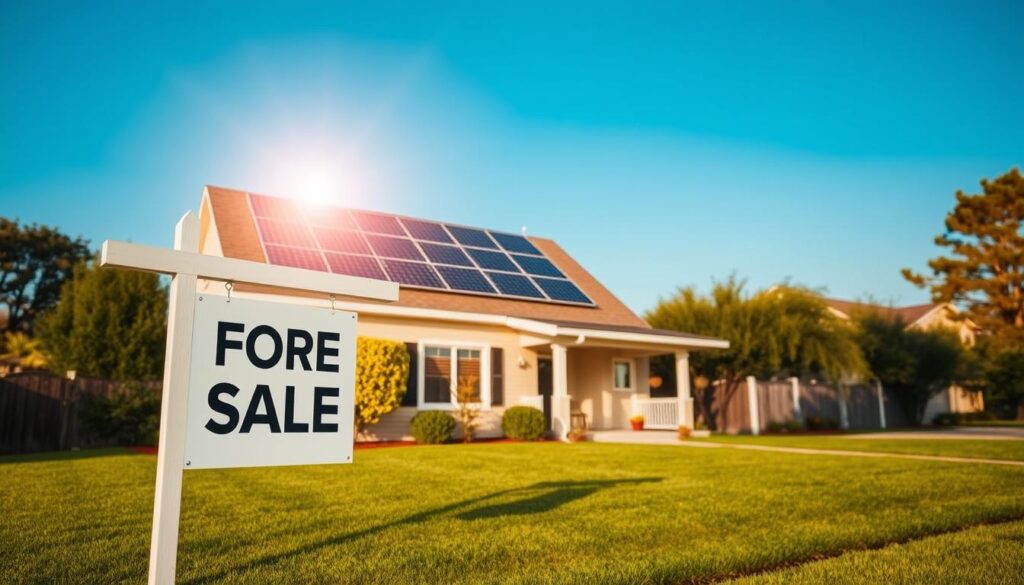Last updated on October 19th, 2025 at 08:22 am
Selling a house with solar panels can be a difficult process because most buyers aren’t educated about the system itself. While many buyers want energy-efficient houses, they are going to worry about how much it’s going to cost.
This broad guide will help you successfully sell your solar-operated house, understand various ownership types to address the buyer’s concerns, and get the most money for your property.
🏠☀️ Selling Your Solar Home
Your Complete Guide to Successfully Selling a House with Solar Panels
Understanding Solar Panel Ownership
🏆 Owned Solar Systems
- Direct energy savings
- Increased property value
- Simple transfer process
- No ongoing contracts
- Higher upfront investment
📋 Leased Solar Systems
- Lower initial costs
- Maintenance included
- Contract transfer required
- Buyer assumption needed
- Potential buyer hesitation
5 Steps to Prepare Your Solar Home
Gather Documentation
Collect all solar agreements, warranties, maintenance records, and performance data
Resolve Legal Issues
Clear any liens, transfer contracts, and ensure all payments are current
Document Performance
Show energy savings, utility bill reductions, and system efficiency data
Highlight Benefits
Emphasize cost savings, environmental impact, and property value increase
Market Effectively
Use professional photos and detailed MLS descriptions showcasing solar features
Cost Breakdown & Savings
| Component | Estimated Cost | Potential Savings |
|---|---|---|
| Installation | $15,000 | Up to $3,000 annually |
| Maintenance | $300/year | $10,000 home value increase |
| Insurance Adjustment | $150/year | Energy savings offset costs |
Essential Documents to Prepare
📁 Required Documentation
- Solar panel purchase or lease agreement
- Warranty details (panels, inverter, workmanship)
- Maintenance records and installer details
- Utility savings reports
- Tax credit information
- Energy output reports
- Installation documentation
Overcoming Common Challenges
Legal & Financial
Address liens, contracts, and payment obligations before listing
HOA Restrictions
Understand community rules and communicate compliance to buyers
Low Appraisals
Work with solar-knowledgeable appraisers and provide comparable sales data
Maintenance Concerns
Show maintenance schedules and provide service provider contacts
💡 Pro Tip: Transparency is Key
Be as honest as you can be about costs, savings, and any challenges. Educated buyers are more confident buyers. You can build trust by showing buyers your real utility bills and how much you’re saving.
Ready to Sell Your Solar Home?
With proper preparation and transparency, your solar panels can be a major selling point. Focus on the long-term savings, environmental benefits, and increased property value to attract the right buyers.
5-step process to prepare your solar house for sale
Step 1: Collect all the necessary documents
Before listing your home, compile a full solar documentation package. This transparency instills confidence in the buyer and streamlines the sales process.
Step 2: Resolve All Legal and Financial Issues
Address any complications before they become deal-breakers. This proactive approach prevents last-minute surprises that could derail your sale.
Key areas to address:
- Clear any existing liens on solar installations
- Make sure all payments are up-to-date (particularly payments for leased systems)
- Settle any maintenance or warranty problems that are left outstanding
- Verify that all permits and inspections are current
- Understand the requirements for contract transfer for leased systems
Step 3: Document Solar System Performance
Performance documentation should include:
Concrete performance data convince skeptical buyers and justify asking price. Buyers want proof that the system actually delivers the promised savings.
- Monthly and annual energy production reports
- Utility bill comparisons showing before/after solar installation
- System efficiency ratings and degradation information
- Maintenance logs proving proper system care
- Any performance guarantees or warranties still in effect
Step 4: Highlight the Benefits Effectively
Transform potential buyer concerns into selling points by clearly communicating the advantages of solar ownership.
Step 5: Market Your Solar Home on a Strategic Level
Your marketing program should treat solar panels as the centerpiece of the sale rather than an afterthought.
Overcoming Common Selling Challenges
Legal and Financial Obstacle Resolution
Lien Issues: Work with your solar installer or financing company to resolve any outstanding liens before listing. Buyers want assurance that the title will be clear at closing.
Contract Complications: For leased systems, contact your solar company early to understand transfer requirements. Some buyers may need to qualify for lease assumption.
HOA Restrictions and Local Regulations
Understanding Local Rules: Building codes and zoning laws vary by location. Ensure your installation meets all current standards and obtain documentation proving compliance.
HOA Compliance: If your home is in an HOA community, gather documentation showing your solar installation meets community guidelines. Address any aesthetic concerns proactively.
Addressing Appraisal Challenges
Working with Appraisers: Find appraisers experienced with solar properties. Provide them with:
Information about solar incentives and their impact on value
Avoiding Low Appraisals: Prepare a comprehensive package for appraisers including installation costs, energy savings data, and market comparisons.

Bottom Line
Selling a house with solar panels comes with its own set of challenges. Knowing if your system is leased or owned is key.
If you have a house with solar panels you want to sell, get a quote instantly.
